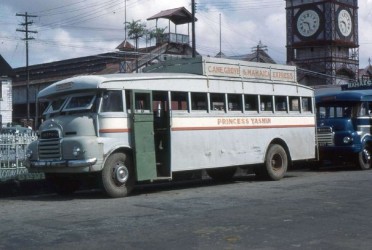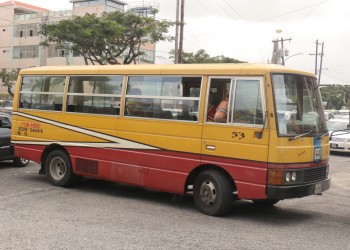For many persons born in Guyana within the last three decades, the concept of riding in a big yellow bus is a foreign one and if you were to ask if they knew about the blue buses that traversed the rural routes, they would stare at you agog.

Long before the 70s, yellow buses were all the rage and many persons who would have been on them can fondly recollect on their presence at the Stabroek Market and throughout Georgetown.
One such person is Albert Bacchus who actually dealt with the big buses hands-on during his time with Motor Transport. Bacchus began working with the company in 1969 and left in 1985. During his time, he worked his way up from a mechanic to a senior mechanic, then a foreman to an assistant superintendent and finally superintendent.
He explained to Stabroek News that, as a foreman, he had to have a licence to drive the buses and had attended to breakdowns and repairs countless times as part of his job.
For Bacchus, the yellow bus service was the ‘golden age’ for public transportation in Guyana.
“In those days there were scheduled runs,” he stated. “In different areas there would be a route and the route would have timings. That way you know for sure every hour in a particular area you would get a bus passing through there,” he added.
Though most of his time was spent under the buses doing maintenance work, Bacchus fondly remembered the times he would spend on the bus – well, something like that.
“Being a staff, we never used to pay to go into the vehicles; we would just ride on the foothold so we never used to pass the turnstile. See, if you passed the turnstile you’d have to pay the fare,” he said with a smile. He went on, “As passengers came on we would have to come off [of the foothold] to let them in and out. That was just our routine.”

According to Bacchus, the running of the yellow bus system was a very well-oiled machine. For one, he said, the fares were very affordable at 8 cents per person. He further said that the Motor Transport had a fleet of 42 yellow buses which operated mainly around Georgetown. The buses would move off at different times, the earliest being at 5.30 am while the last bus ended at 11 pm.
When questioned on out of town trips, he explained, “There were different license fares to run between Georgetown and Rosignol and between Georgetown and Linden,” Bacchus said. He continued, “The license revenue for the city was cheaper to run than out of town so most of the buses ran in town.”
He added that the buses underwent regular maintenance to optimize safety, with daily checks being carried out by the company’s mechanics along with regular service maintenance after the buses had travelled a certain number of miles. There were also examinations every six months by the police, he said.
“To get to the required standard we had to do all of the necessary maintenance stuff. For example, if a bus comes into the workshop and it has a liner that is gone halfway, we’d replace it right away if we know it can’t make it through the six months,” Bacchus said.
Despite the stringent maintenance work, there were a few accidents. However, Bacchus said, none were major.
He recalled one incident where he had to appear before the court after one of the company’s buses ran off Regent Street into the drain.
The driver, Bacchus said, had claimed that the accident had been a mechanical problem due to a failure of the brakes.
“We took safety very seriously then,” Bacchus said. He went on, “The guy was taken to court because he was charged with dangerous driving and to represent the mechanical section I had to go to court and explain my findings at the time.”
Though the buses were very popular, the popularity began to wane when the management was changed from private to public. According to Bacchus, the Motor Transport was taken over by the government and renamed Guyana Transport sometime in the 70s.
“The same rigidness of the maintenance and staff discipline faded with time because the government’s management wasn’t that serious or stern in certain areas,” Bacchus said.
After a while, the fleet of yellow buses was replaced by the big Tata buses, which came from India. Maintenance was also an issue with the new fleet.
Minibuses eventually began to make their appearances in the mid 8os, Bacchus estimated. There were still big buses along the streets at that time but the fleet slowly diminished and the minibuses began to capitalize on their disappearance.
“The minibuses began dominating the scene and eventually the big buses just faded out,” Bacchus said.
In reflection, he believes that the big buses are a better alternative to the current bus transportation situation in Guyana.
He opined, “The big buses were safer and they were more disciplined in regard to their operation and the using of the road. Like, you couldn’t stop away from the bus stop with the big buses, you had to stop at the bus stop.” He further explained, “If it wasn’t a charge by the police, the drivers would get a departmental charge for that offence. So, they were much, much more disciplined.”
He continued, “Also, at one time, our drivers had to wear a cap and tie so they were properly dressed. They were also more in line because if a complaint went against them, we had a system called demotion that would deduct a day’s pay for their wrongdoings. It was a situation that you had to stay disciplined or lose from your earning.”
This is a vast contrast to modern-day Guyana, he said. “Right now with the minibuses there is no discipline. The drivers stop anywhere and the drivers and conductors alike are rude. It’s definitely a bad image on the mode of transportation in this country; it’s terrible,” he lamented.
Around Georgetown, some big buses can still be spotted, most of them travel to far locations such as Linden. Private companies have also set out on providing this mode of transportation, primarily to large groups of tourists.
However, these services are just a shadow of the glory days and though many persons long for the reappearance of the timely big buses, they doubt the buses will ever return.








